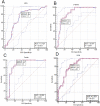The role of electrolyte imbalances in predicting the severity of COVID-19 in the hospitalized patients: a cross-sectional study
- PMID: 36042344
- PMCID: PMC9424795
- DOI: 10.1038/s41598-022-19264-8
The role of electrolyte imbalances in predicting the severity of COVID-19 in the hospitalized patients: a cross-sectional study
Abstract
Coronavirus disease 2019 (COVID-19) can be fatal in severe cases. Accordingly, predicting the severity and prognosis of the disease is valuable. This study examined the role of electrolyte imbalances in predicting the severity of COVID-19. In this cross-sectional study, 169 hospitalized patients with COVID-19 were included and categorized into three groups based on the severity of the disease (moderate, severe, and critical). Serum levels of electrolytes (calcium [Ca], phosphorus [P], sodium [Na], potassium [k], and magnesium [Mg]), inflammatory markers (D-dimer, C-reactive protein [CRP], ferritin, and lactate dehydrogenase [LDH]), and 25OHVitamin D were measured. The mean age of patients was 53 years, and 54% were male. They had moderate, severe, and critical illnesses in 22%, 47%, and 31%, respectively. CRP, D-dimer, and ferritin increased with the severity of the disease. The lower median values of Mg, Na, 25OHVitamin D, Ca, LDH, and higher median lymphocyte counts were observed in the moderate vs. the severe group (P < 0.05). These parameters have acceptable sensitivity and specificity at the suggested cut-off level to discriminate the moderate and critical cases. Serum parameters introduced in this study are appropriate for differentiating between critical and moderate cases. The electrolyte imbalance can predict critical patients.
© 2022. The Author(s).
Conflict of interest statement
The authors declare no competing interests.
Figures
Similar articles
-
Mortality in Patients of COVID-19 Infection: Biochemical Markers and its Cut-off Values for Predicting Outcome.J Coll Physicians Surg Pak. 2022 Jan;32(1):37-41. doi: 10.29271/jcpsp.2022.01.37. J Coll Physicians Surg Pak. 2022. PMID: 34983145
-
The role of laboratory parameters in predicting severity of COVID-19 disease in pregnant patients.J Obstet Gynaecol. 2022 Aug;42(6):1917-1921. doi: 10.1080/01443615.2022.2054681. Epub 2022 May 23. J Obstet Gynaecol. 2022. PMID: 35603633
-
Neutrophil to lymphocytic ratio and other inflammatory markers as adverse outcome predictor in hospitalized COVID-19 patients.Egypt J Immunol. 2022 Apr;29(2):57-67. Egypt J Immunol. 2022. PMID: 35436055
-
D-Dimer, ferritin, and lactate dehydrogenase (LDH) as predictors of mortality in hospitalized COVID-19 patients.J Infect Dev Ctries. 2024 Sep 30;18(9.1):S27-S32. doi: 10.3855/jidc.18833. J Infect Dev Ctries. 2024. PMID: 39499744
-
Predictors of disease severity and outcome of hospitalized renal transplant recipients with COVID-19 infection: a systematic review of a globally representative sample.Rom J Intern Med. 2021 Mar 5;59(1):10-42. doi: 10.2478/rjim-2020-0034. Print 2021 Mar 1. Rom J Intern Med. 2021. PMID: 33155999
Cited by
-
Inflammatory, Hematological, and Biochemical Biomarkers in COVID-19 Patients.Immun Inflamm Dis. 2024 Dec;12(12):e70078. doi: 10.1002/iid3.70078. Immun Inflamm Dis. 2024. PMID: 39641395 Free PMC article.
-
A Clinical Risk Score Based on Albumin and Electrolyte Levels for Predicting Death Risk in Hospitalized Elderly COVID-19 Patients.Int J Gen Med. 2025 Apr 13;18:2119-2129. doi: 10.2147/IJGM.S510647. eCollection 2025. Int J Gen Med. 2025. PMID: 40256421 Free PMC article.
-
Association Between Nursing Diagnoses and Mortality in Hospitalized Patients with COVID-19: A Retrospective Cohort Study.Nurs Rep. 2025 Apr 28;15(5):147. doi: 10.3390/nursrep15050147. Nurs Rep. 2025. PMID: 40423181 Free PMC article.
-
Calcium, phosphorus, magnesium levels in frequent respiratory tract infections.Ann Med. 2023;55(2):2304661. doi: 10.1080/07853890.2024.2304661. Epub 2024 Jan 17. Ann Med. 2023. PMID: 38233369 Free PMC article.
-
Importance of Magnesium Status in COVID-19.Biology (Basel). 2023 May 18;12(5):735. doi: 10.3390/biology12050735. Biology (Basel). 2023. PMID: 37237547 Free PMC article. Review.
References
-
- Cpere N. The epidemiological characteristics of an outbreak of 2019 novel coronavirus diseases (COVID-19) in China. Zhonghua liu xing bing xue za zhi = Zhonghua liuxingbingxue zazhi. 2020;41(2):145. - PubMed
MeSH terms
Substances
LinkOut - more resources
Full Text Sources
Medical
Research Materials
Miscellaneous



